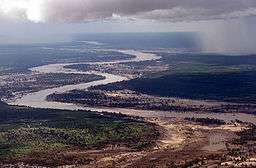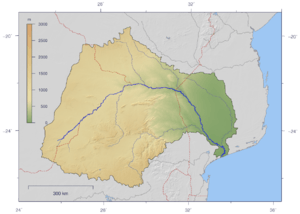Limpopo River
| Limpopo River | |
| Vhembe | |
| River | |
 Limpopo River in Mozambique | |
| Countries | South Africa, Botswana, Zimbabwe, Mozambique |
|---|---|
| Source confluence | Marico and Crocodile |
| - location | Botswana/South Africa border |
| - elevation | 872 m (2,861 ft) |
| Mouth | Indian Ocean |
| - location | Gaza Province, Mozambique |
| Length | 1,750 km (1,087 mi) |
| Basin | 415,000 km2 (160,232 sq mi) |
| Discharge | |
| - average | 170 m3/s (6,003 cu ft/s) |


The Limpopo River rises in central southern Africa, and flows generally eastwards to the Indian Ocean. The term Limpopo is the modified version of the original Sepedi name diphororo tša meetse, meaning ″gushing strong waterfalls". The river is approximately 1,750 kilometres (1,087 mi) long, with a drainage basin 415,000 square kilometres (160,200 sq mi) in size. The mean discharge measured over a year is 170 m3/s (6,200 cu ft/s) at its mouth.[1] The Limpopo is the second largest river in Africa that drains to the Indian Ocean, after the Zambezi River.
The first European to sight the river was Vasco da Gama, who anchored off its mouth in 1498 and named it Espiritu Santo River. Its lower course was explored by St Vincent Whitshed Erskine in 1868–69, and Captain J F Elton travelled down its middle course in 1870.
Course
The Limpopo River flows in a great arc, first zigzagging north and then north-east, then turning east and finally south-east. It serves as a border for about 640 kilometres (398 mi), separating South Africa to the southeast from Botswana to the northwest and Zimbabwe to the north. Two of its tributaries, the Marico River and the Crocodile River join, at which point the name changes to Limpopo River. There are several rapids as the river falls off Southern Africa's inland escarpment.
The Notwane River is a major tributary of the Limpopo, rising on the edge of the Kalahari Desert in Botswana and flowing in a north-easterly direction.[2] The main tributary of the Limpopo, the Olifants River (Elephant River), contributes around 1,233 million m3 of water per year.[3] Other major tributaries include the Shashe River, Mzingwane River, Crocodile River, Mwenezi River and Luvuvhu River.[4]
In the north-eastern corner of South Africa the river borders the Kruger National Park.
The port town of Xai-Xai, Mozambique is on the river near the mouth. Below the Olifants, the river is permanently navigable to the sea, though a sandbar prevents access by large ships except at high tide.
Tributaries
Left hand
- Notwane River
- Bonwapitse River
- Mahalapswe River
- Lotsane River
- Motloutse River
- Shashe River
- Umzingwani River
- Bubi River
- Mwenezi River
- Changane River
Right hand
- Marico River
- Crocodile River
- Matlabas River
- Mokolo River
- Palala River
- Mogalakwena River
- Kolope River
- Sand River (Limpopo)
- Nwanedi River
- Luvuvhu River
- Olifants River (Limpopo)
Basin characteristics
The waters of the Limpopo flow sluggishly, with considerable silt content. Rainfall is seasonal and unreliable: in dry years, the upper parts of the river flow for 40 days or less. The upper part of the drainage basin, in the Kalahari Desert, is arid but conditions become less arid further downriver. The next reaches drain the Waterberg Massif, a biome of semi-deciduous forest and low-density human population.[5] About 14 million people live in the Limpopo basin. The fertile lowlands support a denser population. Flooding during the rainy season is an occasional problem in the lower reaches. During February 2000 heavy rainfalls (due to a cyclone) caused the catastrophic 2000 Mozambique flood.
The highest concentration of hippopotamus in the Limpopo River is found between the Mokolo and the Mogalakwena Rivers.[6]
There is a lot of mining activity in the Limpopo River basin with about 1,900 mines, not counting about 1,700 abandoned mines.[7]
History
Vasco da Gama on his first expedition, was probably the first Europeans to sight the river, when he anchored off the mouth in 1498. However, there has been human habitation in the region since time immemorial — sites in the Makapans Valley near Mokopane contain Australopithecus fossils from 3.5 million years ago. St Vincent Whitshed Erskine, later Surveyor General for South Africa, was the first European to travel down the length of the Limpopo river to its mouth in 1868.

The British author Rudyard Kipling popularized the Limpopo in his short story "The Elephant's Child", in the Just So Stories, in which he described "the great grey-green, greasy Limpopo River, all set about with fever-trees," where the "Bi-Coloured Python Rock-Snake" dwells.[8]
A Zambezi shark (Carcharhinus leucas) was caught hundreds of kilometres upriver at the confluence of the Limpopo and Luvuvhu Rivers in July 1950. Zambezi sharks tolerate fresh water and can travel far up the Limpopo.[9]
In 2013, approximately 15,000 crocodiles were released into the Limpopo River from flood gates at the nearby Rakwena Crocodile Farm.[10]
See also
- Limpopo Water Management Area
- Great Limpopo Transfrontier Park
- List of international border rivers
- Drainage basin A
References
- ↑ Nakayama, Mikiyasu (2003). International Waters in Southern Africa. United Nations University Press. p. 9. ISBN 92-808-1077-4.; online at Google Books
- ↑ The Notwane River, Botswana
- ↑ Görgens, A.H.M. and Boroto, R.A. 1997. Limpopo River: flow balance anomalies, surprises and implications for integrated water resources management. In: Proceedings of the 8th South African National Hydrology Symposium, Pretoria, South Africa.
- ↑ Major rivers and streams within the Limpopo River Basin
- ↑ C.Michael Hogan, Mark L. Cooke and Helen Murray, The Waterberg Biosphere, Lumina Technologies, May 22, 2006.
- ↑ State of Rivers Report: the Mokolo River
- ↑ Mines in the Limpopo River basin
- ↑ The Elephant's Child, Rudyard Kipling
- ↑ Pienaar, U. de V., The Freshwater Fishes of the Kruger National Park, Koedoe Vol 11, No 1 (1968)
- ↑ http://www.reuters.com/article/2013/01/25/us-safrica-crocodiles-idUSBRE90N0OT20130125
External links
| Wikimedia Commons has media related to Limpopo River. |
- Climate change implications for water resources in the Limpopo River Basin, study by IFPRI
- Green and blue water accounting in the Limpopo and Nile Basins, study by IFPRI
- Limpopo Watercourse Commission (LIMCOM) www.limcom.org
- Limpopo River Awareness Kit
- FROC - Reference frequency of occurrence of fish species in South Africa
Coordinates: 25°10′S 33°35′E / 25.167°S 33.583°E